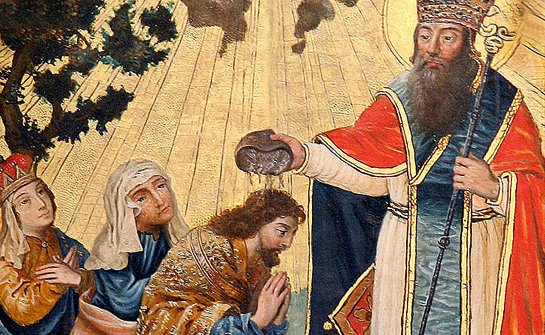
THE ARMENIAN CHURCH: A BRIEF INTRODUCTION
The Church was founded by Jesus Christ. According to tradition, two of His Apostles ― St. Thaddeus and St. Bartholomew ― preached His Gospel in Armenia as early as the second half of the first century. Then in the early fourth century St. Gregory the Illuminator formally established the Church in Armenia, when King Tiridates III was baptized and declared Christianity as the state religion. St. Gregory (c. 240-325 AD) was a descendant of a noble house in Parthia, who was brought up as a Christian in Cappadocia. He was consecrated a bishop by Leontius, the metropolitan of Caesarea, as the first Bishop of Armenia. He began his missionary work in Armenia during the first decade of the fourth century, while a layman ― and upon is consecration as Bishop ― he established the Armenian nation’s Holy See in Vagharshapat (Etchmiadzin). He is called Illuminator for “enlightening the nation with the light of the gospel” through baptism. Etchmiadzin, literally, means “the only begotten descended.” According to tradition, St. Gregory saw Christ in a vision, who indicated to him where to build His Church, the first Armenian Church.
Indeed, the Christianization of Armenia “determined the entire future course of Armenian history”. As the new Faith took roots in the life of the nation, the invention of an Armenian alphabet was necessitated. Realizing the needs of the Armenian faithful, in 406, St. Mesrob Mashdotz created the Armenian alphabet, under the auspices of Catholicos Sahag, in order to make the Christian faith accessible to the people in a written form. Greek and Syriac were the languages used in the church services.
Soon after the invention of the alphabet, St. Mesrob together with St. Sahag and a group of associates ― known as Holy Translators ― translated the Holy Scriptures into Armenian, followed by the biblical, theological and liturgical writings of eminent church fathers. This most important era is known as the Golden Age of Armenian history.
The following centuries were difficult periods in Armenian history, starting with Persian rule (430-634) and later Arab domination (c. 654-851). In the 9th century (c. 885) there was an independent kingdom of the Bagratids in Armenia, however it ended in 1079. In the medieval Kingdom of Cilicia, or Lesser Armenia, there was an independent entity from the end of the 12th century to 1375. Persecution and martyrdom had become common occurrences. A larger proportion of Armenians were massacred in the Ottoman Empire starting in the late 19th century to the Genocide in the early 20th century. Armenians also suffered under the Russians starting in 1893 and later in the Soviet Union until the 1980s.
THE FAITH OF THE ARMENIAN CHURCH
The Faith of the Armenian Church is transmitted through the church’s Holy Tradition, that is, the ongoing life of the church from the time of Christ to our times. The Bible, liturgy and worship, writings of the church fathers, church councils, saints, canons, religious art and rituals ― organically linked together ― formulate the Holy Tradition of the Church. This Faith is articulated in the Creed of the Armenian Church, the formal declaration of beliefs, which in turn defines the church’s raison d’etre and sets the parameters of its mission and functioning.
The Armenian Church professes her faith in the context of her worship. Theologically, whatever the church believes, the church prays. As such, the Armenian Church’s worship and liturgy constitute a prime source for teaching and living her faith. Tradition, on the other hand, defines and formulates the “articles of faith” and transmits them from generation to generation.
As articulated in the Creed, the Armenian Church believes in One God, the Father Almighty who is the Creator of heaven and earth, of all things visible and invisible. Humanity (male and female) is created in the image and likeness of God, and as such is a special creature. However, because of the Fall of man, sin entered the world.
The Church believes in Jesus Christ, “the only begotten Son of God, who came down from heaven, was incarnate, was born of the Virgin Mary, by the Holy Spirit.” He became man, suffered and was crucified, and was buried. He rose again from the dead on the third day and ascended into heaven and sits at the right hand of the Father. He will come again with glory to judge the living and the dead.
The Armenian Church believes in the Holy Spirit, uncreated and perfect, who proceeds from the Father, and together with the Father and the Son is worshipped and glorified. The Holy Spirit spoke to the prophets and apostles and descended into the Jordan river, witnessing Christ’s Baptism.
The Armenian Church is One, Holy, Apostolic, Catholic Church. She believes in one Baptism with repentance for the remission and forgiveness of sins. On judgment day, Christ will call all men and women who have repented to eternal life in His Heavenly Kingdom, which has no end. Christ overcame the power of death with His own death and gave salvation to all mankind. The dogmas of the Armenian Church are based on these “articles of faith.”
FAMILY OF CHURCHES
The Armenian Church belongs to the Orthodox family of churches, known as the Oriental Orthodox, or Non-Chalcedonian, Churches: the Armenian, Coptic, Syrian, Indian Malabar, Ethiopian and Eritrean churches.
Generally, Christianity is divided mainly between Eastern and Western churches. The relationship between Byzantium (East) and Rome (West) deteriorated gradually. In the ninth century a schism between the Byzantine Church and the Church of Rome started to shape during the time of Patriarch Photius. In 1054, anathemas were declared by both sides (Patriarch Michael and Cardinal Humbert), which lasted for centuries. By 1204, when the Crusaders captured Constantinople, the schism had become final. In 1965, following the Vatican II Council, the anathemas were lifted by both sides in a spirit of ecumenism and understanding among the churches.
-Hratch Tchilingirian
